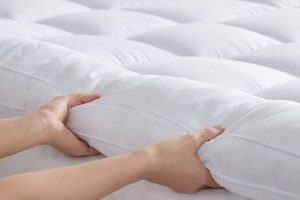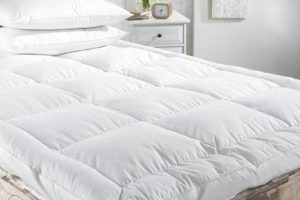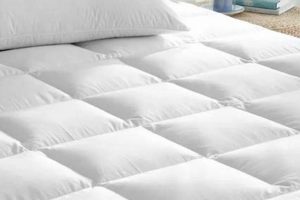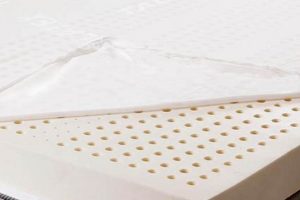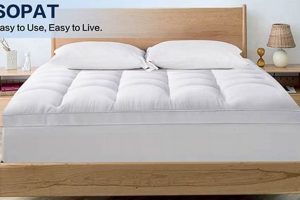A common desire is to enhance the support provided by a sleeping surface. This objective is frequently achieved through the addition of an extra layer designed to modify the existing feel of a bed. Such an addition aims to reduce excessive sinking and promote a more stable and level sleeping area. For example, an individual experiencing back pain on a too-soft mattress might seek a solution to create a more rigid surface.
Modifying a bed’s firmness can improve sleep quality and alleviate pressure points. Historically, methods to adjust mattress feel were limited, often involving replacing the entire mattress. Modern advancements have provided cost-effective and convenient alternatives. This addresses concerns regarding comfort, support, and proper spinal alignment without necessitating a complete mattress overhaul.
The subsequent sections will detail various aspects related to achieving a firmer sleep surface, including material types, density considerations, and specific product characteristics, all with the intention of presenting strategies for improving the overall sleep experience.
Strategies for Achieving a Firmer Sleeping Surface
The following guidance focuses on methods to increase the firmness of a mattress, offering practical advice for improving sleep support and comfort.
Tip 1: Prioritize High-Density Materials: When selecting a topper, opt for dense materials like latex or high-density memory foam. Denser materials provide greater resistance to compression, leading to a firmer feel.
Tip 2: Consider Topper Thickness: Thicker toppers, particularly those made of firm materials, will significantly alter the feel of a mattress. Assess the existing mattress’s sinkage and select a thickness accordingly.
Tip 3: Evaluate Material Composition: The specific material blend influences firmness. Latex generally provides a resilient firmness, while memory foams firmness varies depending on its density and formulation. Research material characteristics before purchase.
Tip 4: Check the Indentation Load Deflection (ILD) Rating: ILD, often provided in product specifications, indicates material firmness. Higher ILD values signify greater firmness.
Tip 5: Integrate a Firm Foundation: Ensure the existing mattress is supported by a solid, non-sagging foundation. A weak foundation compromises the effectiveness of any topper intended to increase firmness.
Tip 6: Rotate and Flip Regularly (if applicable): If the chosen topper is flippable, rotate and flip it periodically to ensure even wear and maintain firmness across the entire surface. Solid toppers, rotate only.
Implementing these strategies contributes to a more supportive sleep environment, potentially improving spinal alignment and reducing discomfort. Consider these points when selecting a method for enhancing mattress firmness.
The concluding sections will delve into specific product recommendations and further considerations for achieving an optimal sleeping experience.
1. Density
Density, in the context of mattress toppers, directly influences the firmness achieved. A high-density material offers greater resistance to compression, effectively mitigating the sinking sensation associated with softer mattresses. This increased resistance translates to a firmer sleeping surface. Conversely, a low-density topper will compress more easily, providing minimal support and potentially exacerbating the softness of the underlying mattress. The causal relationship is straightforward: increased density leads to increased firmness.
The importance of density is evident in product performance and longevity. A high-density topper maintains its structural integrity over time, resisting sagging and providing consistent support. For example, a latex topper with a density of 4-5 pounds per cubic foot will offer significantly more support than a memory foam topper with a density of 2-3 pounds per cubic foot. Individuals requiring substantial back support will benefit from a higher density to maintain proper spinal alignment throughout the night. Understanding this connection is essential for selecting a product that effectively addresses the softness of an existing mattress.
In summary, density is a critical determinant of a mattress topper’s firming capability. Its impact extends beyond initial feel, influencing long-term support and durability. The challenge lies in accurately assessing and comparing density values across different materials and manufacturers. Understanding the principles underlying density and its effect on firmness enables consumers to make informed decisions, leading to a more comfortable and supportive sleeping experience.
2. Material Type
The material composition of a mattress topper is a primary determinant of its capacity to increase the firmness of a bed. Varying materials possess inherent characteristics that directly affect the level of support and resistance they offer. For instance, latex, particularly Dunlop latex, exhibits a naturally firm and resilient quality, providing substantial support and minimizing sinkage. Conversely, traditional memory foam, while conforming to the body, tends to soften under pressure, offering less inherent firmness compared to latex. The material, therefore, exerts a causative influence on the resulting firmness.
Material type also dictates the topper’s ability to distribute weight and alleviate pressure points while maintaining overall firmness. A dense, high-quality latex topper distributes weight evenly, preventing localized sinking and preserving a firm surface. Cheaper, less dense materials, such as low-grade memory foam or fiberfill, lack the structural integrity to provide consistent support across the entire sleeping surface. This disparity is practically observed when comparing the back support offered by a latex topper versus a down alternative topper; the former consistently provides greater resistance and firmness. Understanding the specific properties of each material enables informed decisions aligning with individual firmness preferences.
In summary, the selection of material type significantly impacts the capability of a mattress topper to enhance bed firmness. The inherent qualities of materials like latex contribute to a firmer feel, while others, such as low-density memory foam, offer less support. The challenges in material selection lie in accurately assessing density and quality, coupled with understanding individual support needs. Proper assessment ensures that the chosen topper effectively achieves the desired firmness level, resulting in a more comfortable and supportive sleep environment.
3. Thickness
Thickness is a criti
cal parameter when considering how a mattress topper contributes to increased bed firmness. The depth of the topper directly influences the degree to which it alters the existing feel of the mattress. A thicker topper, constructed from appropriate materials, provides a greater capacity to resist compression and enhance support.
- Degree of Firmness Modification
A thicker topper generally provides a more substantial alteration to the existing firmness level of a mattress. For instance, a 4-inch latex topper will impart a significantly firmer feel compared to a 2-inch counterpart of the same material and density. This relationship is directly proportional; increased thickness, assuming consistent material properties, results in a greater perceived firmness.
- Impact on Sinkage
Thickness plays a role in reducing excessive sinkage into the mattress. A thicker topper can effectively bridge the gap created by a soft or worn-out mattress, providing a more uniform and supportive surface. The additional material acts as a buffer, preventing the sleeper from sinking too deeply and maintaining a more stable spinal alignment.
- Relationship with Material Density
Thickness must be considered in conjunction with material density. A thick topper made of low-density material may offer minimal firmness, as the material compresses easily under weight. Conversely, a thinner topper of high-density material can provide significant firmness and support. Optimal results require a balance between adequate thickness and appropriate density.
- Influence on Overall Comfort
While firmness is the objective, the thickness of the topper influences overall comfort. Excessive thickness, especially with very firm materials, can create an unyielding sleep surface. Consideration should be given to individual preferences and sleeping positions to ensure the chosen thickness provides adequate support without sacrificing comfort. Trial and error may be required to find the optimal balance.
In summary, the thickness of a mattress topper is a key factor in determining its effectiveness in increasing bed firmness. However, thickness should not be considered in isolation. The ideal thickness depends on the material density, the existing mattress condition, and individual comfort preferences. Proper consideration of these factors ensures that the chosen topper effectively enhances firmness without compromising sleep quality.
4. ILD Rating
Indentation Load Deflection (ILD) rating serves as a quantifiable measure of firmness, directly correlating to the capacity of a mattress topper to increase the firmness of a bed. This rating, expressed in pounds, indicates the force required to compress a material by a specified percentage, typically 25%. A higher ILD value signifies a greater force needed for compression, thereby indicating a firmer material and a greater potential for enhancing mattress firmness. For example, a topper with an ILD of 40 will generally feel firmer than one with an ILD of 20, assuming similar material composition and thickness. This difference has a direct causative effect on the perceived firmness of the sleep surface.
The ILD rating is of paramount importance in the context of selecting a mattress topper intended to augment firmness. It provides a standardized, objective metric for comparing different products, mitigating the subjectivity inherent in descriptions like “firm” or “extra-firm.” A practical application lies in individuals seeking relief from back pain. A mattress that lacks sufficient support can contribute to spinal misalignment and discomfort. By selecting a topper with a higher ILD rating, these individuals can introduce a layer of support that counteracts the excessive softness of the underlying mattress, promoting better spinal alignment and potentially reducing pain. Understanding the practical significance of the ILD rating empowers consumers to make informed purchasing decisions, aligning product characteristics with their specific needs.
In summary, the ILD rating is an essential tool for assessing the firmness potential of a mattress topper. By quantifying the resistance to compression, it provides an objective measure for comparison and selection. While challenges exist in ensuring consistency across different manufacturers’ testing methodologies, the ILD rating remains a valuable indicator of a topper’s ability to increase bed firmness. This understanding links directly to the broader goal of achieving a comfortable and supportive sleep environment, tailored to individual preferences and physical requirements.
5. Support Base
The foundational support system beneath a mattress significantly impacts the effectiveness of any topper intended to increase firmness. An inadequate support base undermines the potential benefits of even the firmest and densest topper, leading to compromised sleep quality and potentially exacerbating existing support issues.
- Influence on Topper Performance
A sagging or uneven support base negates the intended firming effect of a topper. The topper will conform to the deficiencies of the underlying foundation, resulting in inconsistent support and localized sinking. For instance, placing a firm latex topper on a bed frame with bowed or broken slats will not yield a uniformly firm sleep surface; the topper will simply follow the contours of the inadequate support.
- Types of Support Bases
Common support bases include box springs, platform beds, and adjustable frames. Box springs, particularly older models, can lose their rigidity over time, diminishing their ability to provide adequate support. Platform beds, especially those with closely spaced slats, generally offer a more stable and consistent foundation. Adjustable frames, when properly adjusted, can provide targeted support, but their effectiveness relies on their overall structural integrity.
- Assessment of Existing Support
Prior to investing in a mattress topper to increase firmness, the existing support base must be thoroughly assessed. Signs of an inadequate support include visible sagging, creaking or groaning noises, and uneven weight distribution. A simple test involves placing a straight edge across the mattress surface to identify any dips or inconsistencies, indicating a compromised foundation.
- Corrective Measures
If the existing support base is deemed inadequate, corrective measures are necessary before or in conjunction with the addition of a mattress topper. These measures may involve replacing the box spring, reinforcing the bed frame with additional slats, or investing in a new platform bed. Neglecting the support base renders the topper ineffective, representing a misallocation of resources.
In conclusion, the support base constitutes an integral component in achieving the desired firmness enhancement through the use of a mattress topper. Addressing inadequacies in the support system is crucial for realizing the full potential of the topper and ensuring a consistently firm and supportive sleep surface. The interplay between the topper and its foundation dictates the overall sleeping experience, emphasizing the need for holistic consideration.
6. Longevity
The extended usability of a mattress topper designed to enhance firmness directly impacts its value proposition. A durable topper maintains its structural integrity and support characteristics over time, justifying the initial investment and ensuring consistent sleep quality.
- Material Degradation Resistance
The resistance of the topper’s material to degradation dictates its lifespan and sustained firmness. High-quality materials, such as dense latex or resilient memory foam, resist compression set and maintain their supportive properties for an extended period. Lower-quality materials degrade more rapidly, resulting in a loss of firmness and a diminished ability to improve the sleep surface. For example, a high-density latex topper might retain its firmness for 5-7 years, whereas a low-density polyurethane foam topper may only last 1-2 years before losing significant support.
- Structural Integrity Over Time
The topper’s overall structural integrity, including seams, stitching, and internal components, contributes significantly to its longevity. Weak seams or poorly constructed internal supports can lead to premature wear and tear, compromising the topper’s ability to maintain a firm and even surface. A well-constructed topper retains its shape and dimensions, preventing sagging or unevenness that would diminish its firmness and support.
- Impact of Usage and Maintenance
Usage patterns and maintenance practices influence the lifespan of a mattress topper. Excessive weight, improper cleaning, and lack of regular rotation can accelerate wear and tear, reducing the topper’s ability to maintain its intended firmness. Following manufacturer recommendations for care and maintenance, including the use of a protective cover and periodic rotation, can significantly extend the topper’s lifespan and preserve its supportive qualities.
- Correlation with Firmness Retention
The ability of a topper to retain its firmness over its lifespan is a critical indicator of its long-term value. A topper that initially provides significant firmness but quickly loses its supportive properties offers limited long-term benefit. Firmness retention is directly correlated with the quality of materials and construction, as well as the adherence to proper maintenance practices. Consumers should consider long-term firmness retention when evaluating the overall value of a mattress topper intended to enhance bed firmness.
In summary, the longevity of a mattress topper significantly impacts its effectiveness in maintaining a firm sleep surface. Material quality, structural integrity, usage patterns, and maintenance practices all contribute to the topper’s ability to provide consistent support over an extended period. Therefore, when selecting a topper to enhance bed firmness, consider its potential lifespan and the factors that contribute to its long-term performance.
7. Budget
Budgetary constraints play a significant role in the selection of a mattress topper intended to increase bed firmness. The available funds dictate the range of materials, construction quality, and overall product lifespan that a consumer can consider. As a result, the achievable level of firmness enhancement and the long-term value derived from the topper are directly influenced by the allocated budget.
- Material Choices and Associated Costs
Different materials vary substantially in price, directly impacting the feasibility of achieving a desired firmness level within a specific budget. High-density latex, known for its inherent firmness and durability, typically commands a higher price point than conventional memory foam or polyurethane foam. Consumers with limited budgets may be compelled to opt for less expensive materials, potentially compromising the degree of firmness and the topper’s lifespan. This necessitates a careful evaluation of cost versus performance tradeoffs.
- Construction Quality and Longevity Considerations
A larger budget often allows for the selection of toppers with superior construction quality, including reinforced seams, durable covers, and advanced manufacturing techniques. These features contribute to the topper’s ability to maintain its firmness and structural integrity over an extended period. Conversely, budget-constrained purchases may involve compromises in construction quality, resulting in a shorter lifespan and a more rapid decline in firmness. The initial cost savings may be offset by the need for more frequent replacements.
- Density and its Impact on Support and Price
Within the same material category, variations in density significantly affect both the firmness and the cost of a mattress topper. Higher-density foams provide greater resistance to compression, resulting in a firmer and more supportive sleep surface. However, increasing density generally translates to a higher price. Budget-conscious consumers may need to balance their desire for optimal firmness with the affordability of lower-density options. Careful consideration of density specifications is crucial for maximizing the value within a given budget.
- Long-Term Value vs. Immediate Cost Savings
The decision-making process involves weighing the immediate cost savings of a cheaper topper against the potential long-term benefits of a more expensive, higher-quality option. A budget-friendly topper may initially seem appealing but could require replacement sooner due to reduced durability and diminished firmness retention. Investing in a more expensive topper with superior materials and construction may offer better long-term value by providing consistent support and a longer lifespan, ultimately proving more cost-effective over time.
In conclusion, the allocated budget profoundly influences the selection and effectiveness of a mattress topper intended to enhance bed firmness. Constraints necessitate careful consideration of material choices, construction quality, density, and long-term value. Balancing these factors allows consumers to make informed decisions, maximizing the potential for achieving a firmer sleep surface within their financial means.
Frequently Asked Questions
The following questions address common concerns regarding the use of mattress toppers to increase the firmness of a bed. The answers aim to provide clarity and inform decision-making.
Question 1: What types of mattress toppers are most effective at increasing firmness?
High-density latex and certain high-density memory foam toppers generally offer the most substantial increase in firmness. These materials resist compression, providing a more supportive surface.
Question 2: How does topper thickness influence the level of firmness achieved?
A thicker topper will generally provide a more noticeable increase in firmness, assuming the material density is sufficient. The additional material provides greater resistance to sinkage.
Question 3: Can a mattress topper truly compensate for an excessively soft mattress?
While a topper can significantly improve firmness, its effectiveness is limited. An extremely soft or worn-out mattress may still exhibit some sinkage, even with a firm topper. In severe cases, mattress replacement may be necessary.
Question 4: What is the significance of the Indentation Load Deflection (ILD) rating when selecting a firming topper?
The ILD rating quantifies material firmness. A higher ILD indicates greater resistance to compression, suggesting a firmer topper suitable for increasing bed firmness.
Question 5: Does the support base beneath the mattress affect the performance of a firming topper?
Yes, an inadequate support base, such as a sagging box spring, will undermine the effectiveness of even the firmest topper. A solid and even support is essential for maximizing topper performance.
Question 6: How long can a mattress topper be expected to maintain its firmness?
The lifespan of a firming topper depends on material quality, usage, and maintenance. High-quality latex toppers may retain their firmness for several years, while lower-density materials may degrade more quickly.
These FAQs address critical aspects of using mattress toppers to enhance bed firmness. Careful consideration of these points can lead to a more informed and effective purchase.
The subsequent section will provide practical recommendations for selecting and maintaining a mattress topper to ensure optimal performance and longevity.
Concluding Remarks
The preceding analysis has explored various facets of employing a mattress topper to achieve a firmer sleeping surface. Key considerations include material density, topper thickness, Indentation Load Deflection ratings, the integrity of the underlying support base, and the expected product lifespan. A deliberate evaluation of these parameters is paramount for effectively mitigating excessive mattress softness.
The strategic implementation of a suitable mattress topper represents a viable approach to modifying bed firmness, offering a potential alternative to complete mattress replacement. It is incumbent upon the consumer to correlate their specific support requirements with the inherent characteristics of available products. Continued advancements in material science promise further refinements in topper technology, potentially yielding even more efficacious solutions for optimizing sleep support in the future.


